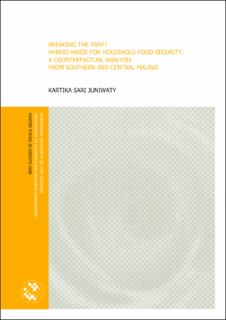| dc.contributor.advisor | Øygard, Ragnar | |
| dc.contributor.author | Juniwaty, Kartika Sari | |
| dc.coverage.spatial | Malawi | en_US |
| dc.date.accessioned | 2020-05-25T10:27:51Z | |
| dc.date.available | 2020-05-25T10:27:51Z | |
| dc.date.issued | 2008 | |
| dc.identifier.uri | https://hdl.handle.net/11250/2655435 | |
| dc.description.abstract | Malawi has changed her position from one of the most food insecure countries to one that is now able to export and donate maize for her neighbors. Subsidy of agriculture inputs and favorable rainfall in 2006/2007 growing season are two explanations of this. Nevertheless, whereas food security at the national level was achieved, some households are still experiencing lack of food.
This study concerns how the condition of food security is changed in the group of “new” adopters of hybrid maize and fertilizer. The term “new” refer to farmers who grow hybrid maize in 2006/2007 cropping season, while they did not grow in the 2005/2006 cropping season. Propensity score matching and difference-in-difference method are used in this study by utilizing two years longitudinal data of 154 households from Southern and Central Malawi. | en_US |
| dc.language.iso | eng | en_US |
| dc.publisher | Norwegian University of Life Sciences, Ås | en_US |
| dc.rights | Attribution-NonCommercial-NoDerivatives 4.0 Internasjonal | * |
| dc.rights.uri | http://creativecommons.org/licenses/by-nc-nd/4.0/deed.no | * |
| dc.title | Breaking the trap? : hybrid maize for household food security : a counterfactual analysis from Southern and Central Malawi | en_US |
| dc.type | Master thesis | en_US |
| dc.description.localcode | M-DRE | en_US |

